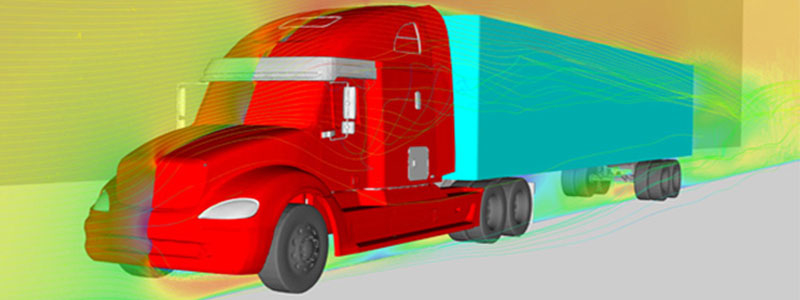High Performance Computing Innovation Center marks second anniversary
The Lawrence Livermore National Laboratory launched an aggressive initiative to boost American industry's global competitiveness on June 30, 2011, by opening the High Performance Computing Innovation Center (HPCIC) in the Livermore Valley Open Campus (LVOC). Using expertise acquired through decades of applying HPC to challenges in a broad range of fields, the HPCIC has been reaching out to industry to broaden the use of supercomputers for the technological and business innovation that underpins the nation's economic vitality.
"The notion that the Lab's world-class supercomputing resources and expertise should be made available to industry to spur technological and business innovation is an idea whose time has come," said Fred Streitz, HPCIC director. "It is, after all, a matter of national security that the country continues to lead in the development of new technologies, new manufacturing capabilities or new businesses, especially amid fierce global competition. There's a growing global consensus that HPC is the key -- in the U.S., for us to maintain, and elsewhere for those striving to claim this leadership."
However, industry's adoption of high end supercomputing has been hindered by one or more barriers, such as the high cost of HPC systems; the lack of software appropriate to the task; or a lack of domain expertise in applying HPC to industrial problems. The HPCIC is designed to remove these hurdles, to demonstrate the potential of supercomputing and to accelerate innovation for economic development.
With Labwide representation in its Business and Technical Advisory Councils, the HPCIC serves as the nexus for HPC business development. It works on such issues as the unified promotion of LLNL computational science and engineering expertise, and the definition and implementation of the Lab's computing access policies. As a business-friendly portal to industry, it helps streamline the business development and contracting process, provides access to LLNL computational resources and offers guidance regarding compliance with regulations and policies.
A primary role for the HPCIC is serving as a gateway for tapping the breadth of LLNL expertise in applying HPC to the development of technological and business solutions. For example, the HPCIC promotes access to Engineering's Turbulence Analysis and Simulation Center (TASC), which focuses on high-performance simulation and analysis of turbulent mixing and reacting flows using advanced numerical methods developed at the Lab and in academia. These capabilities are important to a variety of research areas including the study of jet, rocket and internal combustion engine design, laser fusion, climate change, weather forecasting, pollutant dispersion, wind power and aeroacoustics.
The HPCIC also can engage with industrial and scientific experts through its Deep Computing Solutions (DCS) partnership with IBM Research. Underlying DCS is an agreement allowing computer and domain science experts from IBM Research and LLNL to work with industry collaborators on HPC-related problems and provide solutions that help accelerate the development of new technologies, products and services.
The HPCIC made quick converts of six energy companies selected to partner with LLNL under the hpc4Energy Incubator program. In a November 2012 workshop hosted by the HPCIC, energy company researchers shared their early results. Eugene Litinov, an executive with ISO New England, a non-profit grid management company, told workshop attendees that access to Livermore Computing capabilities allowed his company to "think differently about problems ... You can ask questions you didn't think of asking before."
"The hpc4energy Incubator gave a little taste of what is possible," Streitz said. "When you get researchers from industry and the labs to engage around a compelling idea, and throw high performance computing into the mix -- magic happens."
Dedicated to the kind of collaborative projects that the HPCIC is designed to foster, Vulcan is a 5 petaflop/s (quadrillion floating operations per second) IBM Blue Gene/Q supercomputer and the eighth most powerful system in the June 2013 Top500 list. Vulcan is a quarter-sized version of the 20 petaflop/s Sequoia machine that was ranked the world's most powerful computer in June 2012 and which is now dedicated to national security research.
Companies interested in access to Vulcan, along with other supercomputing services, are invited to respond to FedBizOpps solicitation FBO270-13.
The HPCIC was the inaugural facility in the open campus.
"High performance computing is integral to all of our programs at LLNL, which is why it was appropriate for the HPCIC to be our first venture in the open campus," said Betsy Cantwell, head of economic development for LLNL. "The HPCIC offers a way for LLNL scientists, engineers and business developers to bring our know-howto their problems in a business-friendly environment."
The HPCIC facility has proven to be a popular event venue for many Lab programs. Since opening in late June 2011, the HPCIC has hosted more than 1,500 events and received more than 14,000 visitors. The HPCIC's 60-plus seat class/seminar room and comfortable collaboration space are a favorite gathering place for multi-institutional discussions.
"The Innovation Center has become a hub of collaborative activity and the venue of choice for workshops in a broad range of subjects," Cantwell said. "Clearly, it's filling an important need for LLNL research programs and that bodes well for the future of the Open Campus."
Contact
Donald B Johnston[email protected]
925-423-4902
Related Links
High Performance Computing Innovation CenterLivermore Valley Open Campus
HPC for Energy
Computation at Lawrence Livermore
IBM, Lawrence Livermore researchers form 'Deep Computing Solutions' collaboration to help boost U.S. industrial competitiveness
Lawrence Livermore National Laboratory opens High Performance Computing Innovation Center for collaboration with industry
Tags
HPC, Simulation, and Data ScienceComputing
Industry Collaborations
HPC
HPC Innovation Center
Livermore Valley Open Campus
Featured Articles









